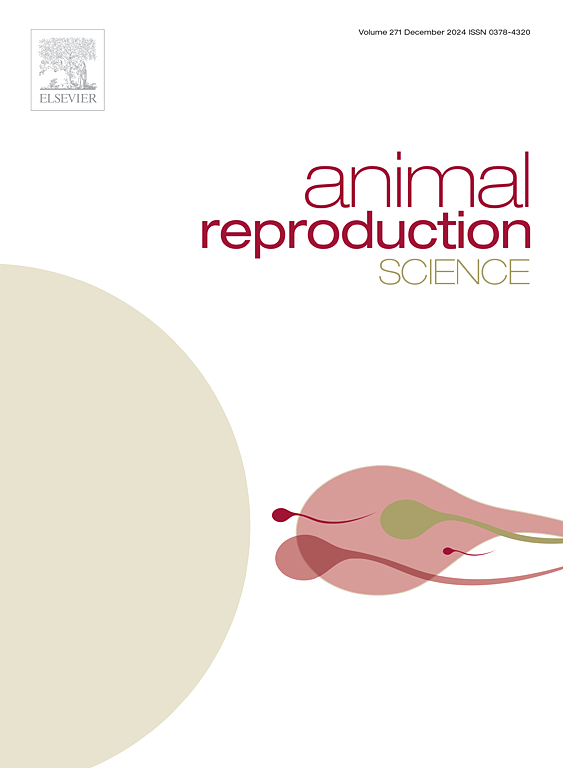Effects of semen collection methods on sperm quality and metabolite profile in goat seminal plasma: Comparing between artificial vagina and electro-ejaculator techniques
IF 2.2
2区 农林科学
Q1 AGRICULTURE, DAIRY & ANIMAL SCIENCE
引用次数: 0
Abstract
This study compared two semen collection methods—artificial vagina (AV) and electro-ejaculator (EE)—to evaluate their effects on sperm quality and the metabolomic profile of goat seminal plasma (SP). Semen samples were analyzed for sperm characteristics, and SP was assessed using ultra-performance liquid chromatography-electrospray ionization quadrupole Orbitrap mass spectrometry. Sperm collected via AV showed lower ejaculate volume but significantly higher concentration and motility than EE. Metabolomic profiling revealed 568 and 350 metabolites in positive and negative ion modes, respectively, with 105 and 77 showing significant differential expression. In the negative ion mode, metabolites such as bezafibrate, phosphatidylinositol 16 and 18, and benzothiazoline were down-regulated in AV, while docosahexaenoic acid, arachidonic acid, phosphatidylcholine, rutin, pyruvate, famotidine, and citrate were up-regulated. In the positive ion mode, metabolites including astaxanthin, lapachol, and 3-acetylaconitine were down-regulated, while mannitol, choline, L-carnitine, and indirubin were up-regulated in AV. KEGG pathway enrichment showed 30 significantly altered pathways. This is the first study to assess the impact of AV and EE on the metabolomic profile of goat SP. The identified metabolites serve as promising biomarkers for evaluating sperm quality and assessing reproductive potential, with implications for improving semen collection techniques and conserving genetic resources.
采集方式对山羊精浆中精子质量和代谢物的影响:人工阴道与电射精器技术的比较
本研究比较了人工阴道(AV)和电射精器(EE)两种采集方法对山羊精浆(SP)代谢组学特征和精子质量的影响。分析精液样本的精子特征,并采用超高效液相色谱-电喷雾电离四极轨道阱质谱法评估SP。与EE相比,通过AV收集的精子体积更小,但浓度和活力显著提高。代谢组学分析显示,568和350种代谢物分别处于正离子和负离子模式,105和77种代谢物表现出显著的差异表达。在负离子模式下,AV的代谢产物如贝扎布酸、磷脂酰肌醇16和18、苯并噻唑啉下调,而二十二碳六烯酸、花生四烯酸、磷脂酰胆碱、芦丁、丙酮酸、法莫替丁和柠檬酸上调。在正离子模式下,虾青素、拉帕柯碱、3-乙酰乌头碱等代谢物在AV中下调,甘露醇、胆碱、左旋肉碱、靛玉红等代谢物在AV中上调。KEGG通路富集显示30条通路发生显著改变。这是第一个评估AV和EE对山羊SP代谢组学特征影响的研究。鉴定的代谢物可作为评估精子质量和生殖潜力的有前途的生物标志物,对改进精液采集技术和保护遗传资源具有重要意义。
本文章由计算机程序翻译,如有差异,请以英文原文为准。
求助全文
约1分钟内获得全文
求助全文
来源期刊

Animal Reproduction Science
农林科学-奶制品与动物科学
CiteScore
4.50
自引率
9.10%
发文量
136
审稿时长
54 days
期刊介绍:
Animal Reproduction Science publishes results from studies relating to reproduction and fertility in animals. This includes both fundamental research and applied studies, including management practices that increase our understanding of the biology and manipulation of reproduction. Manuscripts should go into depth in the mechanisms involved in the research reported, rather than a give a mere description of findings. The focus is on animals that are useful to humans including food- and fibre-producing; companion/recreational; captive; and endangered species including zoo animals, but excluding laboratory animals unless the results of the study provide new information that impacts the basic understanding of the biology or manipulation of reproduction.
The journal''s scope includes the study of reproductive physiology and endocrinology, reproductive cycles, natural and artificial control of reproduction, preservation and use of gametes and embryos, pregnancy and parturition, infertility and sterility, diagnostic and therapeutic techniques.
The Editorial Board of Animal Reproduction Science has decided not to publish papers in which there is an exclusive examination of the in vitro development of oocytes and embryos; however, there will be consideration of papers that include in vitro studies where the source of the oocytes and/or development of the embryos beyond the blastocyst stage is part of the experimental design.
 求助内容:
求助内容: 应助结果提醒方式:
应助结果提醒方式:


